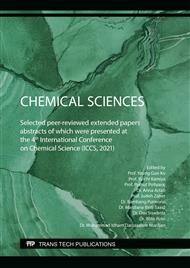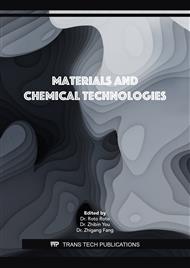[1]
W. Najahi-Missaoui, R.D. Arnold, B.S. Cummings, Safe nanoparticles: Are we there yet ?, Int. J. Mol. Sci. 22 (2021) 385.
DOI: 10.3390/ijms22010385
Google Scholar
[2]
N. Khlebtsov, L. Dykman, Biodistribution and toxicity of engineered gold nanoparticles: A review of in vitro and in vivo studies, Chem. Soc. Rev. 40 (2011) 1647–1671.
DOI: 10.1039/c0cs00018c
Google Scholar
[3]
M. Nadeem, B.H. Abbasi, M. Younas, W. Ahmad, T. Khan, A review of the green syntheses and antimicrobial applications of gold nanoparticles, Green Chem. Lett. Rev. 10 (2017) 216–227.
DOI: 10.1080/17518253.2017.1349192
Google Scholar
[4]
D. Philip, C. Unni, S.A. Aromal, V.K. Vidhu, Murraya koenigii leaf-assisted rapid green synthesis of silver and gold nanoparticles, Spectrochim. Acta, Part A 78 (2011) 899–904.
DOI: 10.1016/j.saa.2010.12.060
Google Scholar
[5]
S.S. Shankar, A. Rai, A. Ahmad, M. Sastry, Rapid synthesis of Au, Ag, and bimetallic Au core-Ag shell nanoparticles using Neem (Azadirachta indica) leaf broth, J. Colloid Interface Sci. 275 (2004) 496–502.
DOI: 10.1016/j.jcis.2004.03.003
Google Scholar
[6]
D.A. Ghafoor, W.M. Saod, N. Mohammed, Green synthesis of gold nanoparticles using pineapple extract and study their analytical characterization and antibacterial activity, Syst. Rev. Pharm. 11 (2020) 462–465.
Google Scholar
[7]
S. Donga, G.R. Bhadu, S. Chanda, Antimicrobial, antioxidant and anticancer activities of gold nanoparticles green synthesized using Mangifera indica seed aqueous extract, Artif. Cells, Nanomed., Biotechnol. 48 (2020) 1315–1325.
DOI: 10.1080/21691401.2020.1843470
Google Scholar
[8]
M. Rakhi, B.B. Gopal, Terminalia arjuna bark extract mediated size controlled synthesis of polyshaped gold nanoparticles and its application in catalysis, Int. J. Res. Chem. Environ. 2 (2012) 338–342.
Google Scholar
[9]
M.Z. Imam, M. Moniruzzaman, Antinociceptive effect of ethanol extract of leaves of Lannea coromandelica, J. Ethnopharmacol. 154 (2014) 109–115.
DOI: 10.1016/j.jep.2014.03.032
Google Scholar
[10]
M. Rahman, A. Khatun, S.J. Uddin, J.A. Shilpi, Comparative effect of Lannea coromandelica (Houtt) Merr leaves and stem barks on acetic acid-induced pain model in mice and chromogenic reagents: Exploring the analgesic potential and phytochemical groups, Pharmacologyonline 1 (2016) 146–152.
Google Scholar
[11]
M.K. Manik, M.A. Wahid, S.M.A. Islam, A. Pal, K.T. Ahmed, A comparative study of the antioxidant, antimicrobial and thrombolytic activity of the bark and leaves of Lannea coromandelica (Anacardiaceae), Int. J. Pharm. Sci. Res. 4 (2014) 2609–2614.
Google Scholar
[12]
A.W. Wahab, A. Karim, N. La Nafie, P. Satrimafitrah, T. Triana, I.W. Sutapa, Production of the nanoparticles using leaf of Muntingia calabura L. as bioreductor and potential as a blood sugar nanosensor, J. Phys.: Conf. Ser. 1242 (2019) 012004.
DOI: 10.1088/1742-6596/1242/1/012004
Google Scholar
[13]
P. Pimpang, S. Choopun, Monodispersity and stability of Gold nanoparticles stabilized by using polyvinyl alcohol, Chiang Mai J. Sci. 38 (2011) 31–38.
Google Scholar
[14]
S.A. Farhan, R.M. Dadoosh, A.M.N. Jassim, Evaluation of phytochemical, total phenolic and antioxidant activity of carica papaya seed for its use in biosynthesis of gold nanoparticles, Egypt. J. Chem. 64 (2021) 4301–4310.
DOI: 10.21608/ejchem.2021.63985.3371
Google Scholar
[15]
K. Shameli, M. Bin Ahmad Ali, A. Zamanian, P. Sangpour, P. Shabanzadeh, Y. Abdollahi, M. Zargar, Green biosynthesis of silver nanoparticles using Curcuma longa tuber powder, Int. J. Nanomedicine 7 (2012) 5603–5610.
DOI: 10.2147/ijn.s36786
Google Scholar
[16]
A. Folorunso, S. Akintelu, A.K. Oyebamiji, S. Ajayi, B. Abiola, I. Abdusalam, A. Morakinyo, Biosynthesis, characterization and antimicrobial activity of gold nanoparticles from leaf extracts of Annona muricata, J. Nanostruct. Chem. 9 (2019) 111–117.
DOI: 10.1007/s40097-019-0301-1
Google Scholar
[17]
M.M.H. Khalil, E.H. Ismail, F. El-Magdoub, Biosynthesis of Au nanoparticles using olive leaf extract: 1st Nano updates, Arabian J. Chem. 5 (2012) 431–437.
DOI: 10.1016/j.arabjc.2010.11.011
Google Scholar
[18]
R.M. Ganesan, H.G. Prabu, Synthesis of gold nanoparticles using herbal Acorus calamus rhizome extract and coating on cotton fabric for antibacterial and UV blocking applications, Arabian J. Chem. 12 (2019) 2166–2174.
DOI: 10.1016/j.arabjc.2014.12.017
Google Scholar
[19]
U. Dippon, S. Pabst, S. Klitzke, Colloidal stabilization of CeO2 nanomaterials with polyacrylic acid, polyvinyl alcohol or natural organic matter, Sci. Total Environ. 645 (2018) 1153–1158.
DOI: 10.1016/j.scitotenv.2018.07.189
Google Scholar



